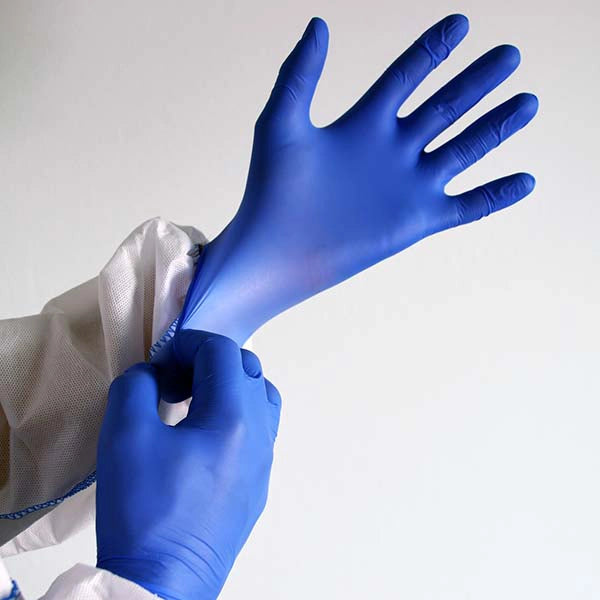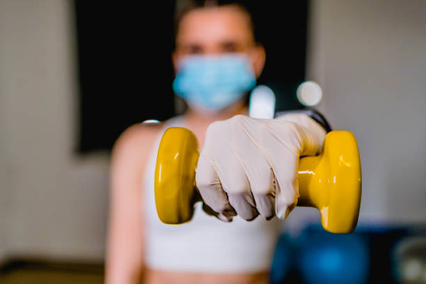When you are choosing a disposable glove it can be overwhelming with such a wide variety to choose from. Some of the best gloves are latex gloves, nitrile gloves, vinyl gloves and many other types. The choices are endless! With so many choices available to buy the decision can get overwhelming, and that’s where this guide comes in.
Purchase disposable gloves that fit your needs. Remember to consider the purpose, quality and if you're allergic to latex. Disposable gloves come in all different types, shapes, uses and prices.
But, how do you choose the best disposable gloves for your needs? In this guide we break it down to make the process of choosing gloves simpler and faster.
Purposes of Disposable Gloves
Disposable gloves are one of the first lines of defense against common workplace injuries and illnesses. Before you buy them, it is important to know what they are being used for as different uses require different types of disposable gloves.
There are two major uses of disposable gloves – medical and general purpose. Both have their own uses and adhere to FDA standards, but it's vital that you also understand their differences.
General purpose disposable gloves are commonly used for:
- Food handling
- Gardening
- Household Chores
- Janitorial
- Salons/Spas
- Automotive
On the other hand, medical gloves are commonly used for:
- Examination gloves
- Surgical gloves
- Chemotherapy Gloves
- Other types of healthcare gloves
Disposable gloves are made out of a variety of materials, and each material has its strengths and weaknesses. Different materials will vary in their level of protection against chemicals, dexterity for grasping tools and ease of cleaning. To get the best performance out of your gloves, you'll want to choose the right material.
Types of Disposable Gloves
There are multiple materials that go into making gloves, and knowing which components those gloves are made of can help you select something that will work seamlessly with the things you need it for. The three materials most commonly used in medical gloves are latex, vinyl, nitrile, and polyethylene. But what makes each of them different?
Nitrile Gloves
You will find nitrile gloves useful in many industrial settings, as they are resistant to a wide range of chemicals and other hazardous substances and they have good tensile properties.
Created from synthetic rubber, nitrile is suitable for those with latex allergies, since it does not contain similar proteins that could cause a reaction. These disposable gloves are latex free gloves, produced through a rigorous process that eliminates the proteins.
Nitrile gloves are impervious to water, which makes them excellent for washing up, while they are also resistant to punctures. This makes them perfect for when you need to handle sharp tools, chemicals or biological hazards.
These disposable gloves also offer protection against a variety of substances and conditions, including biological contaminants like fungus. When it comes to handling glass, electronics, paper and other fragile items, nitrile gloves can help keep your hands safe.
Nitrile gloves are available in numerous sizes and colors. They come in a range of thicknesses, and they can be used for general and medical purposes. They are extremely versatile disposable gloves.
Popular users of nitrile gloves include mechanics, medical professionals, tattooists, people with allergies to latex, laboratory workers, and food handlers.
Latex Gloves
Latex gloves are made of a biodegradable material made from the latex produced by rubber trees. Despite the development of synthetic materials, it's still the most popular glove material because gloves are highly elastic and resilient, and form a snug fit.
Latex gloves offer a great deal of flexibility, so they're perfect for many tasks that require a steady hand and fluid movement. Others even commend latex gloves for its "second skin" feels, letting you touch and perform tasks with precision.
Many people find these disposable gloves comfortable to wear and enjoy using them for long periods of time. These disposable gloves are strong and reliable. They prevent the spread of infectious agents and help to contain contamination to a specified area.
Although latex gloves are common gloves, many people experience allergic reactions to it or develop reactions over time. In fact, latex gloves have been prohibited in some states because of their potential to cause an allergic reaction.
Another downside of latex is these gloves are not resistant to many chemicals and they do not provide as much puncture resistance as nitrile gloves.
Latex gloves are great for medical professionals, beauty industry workers, surgeons and others who need a high level of touch sensitivity, as well as advocates of green practices due to its biodegradable features.
Vinyl Gloves
For those who have had problems with allergies to latex or synthetic accelerators in other gloves, vinyl gloves is another good option. These latex free gloves do not contain accelerators or latex which can cause type I and type IV allergies.
Vinyl gloves are made of vinyl—a synthetic, protein-free, non-biodegradable material containing polyvinyl chloride and plasticizers. Plasticizers are added to PVC to make gloves flexible and comfortable.
Vinyl gloves are one of the most affordable types of gloves available, making them a popular choice among healthcare professionals, food handlers, and other people in heavily-gloved fields. They are also often loose-fitting and easy to change.
While vinyl gloves are usually less expensive than latex and nitrile, they offer limited protection against chemicals and disease. In fact, you should avoid using these gloves when handling fatty foods. The oils may leach out the softening agents into the food, causing the glove to become brittle. As a result of these limitations, these gloves are often used in non-hazardous settings where the risk of infection is low.
These gloves are a great choice for anything where you want a thin glove, like food prep (unless the food is greasy). They're thinner than latex, and some people who are allergic to latex can use them easily. You can also wear the, for low risk procedures and non-hazardous materials.
Polyethylene Gloves
Made from polyethylene and designed to be disposable, poly gloves are perfect for light duty tasks. They are the kind of glove with a looser fit to make it easy to pull them on and off.
Polyethylene gloves are a cost-effective form of disposable PPE. They're made from durable material and protect the wearer from contamination and some hazards during light activities.
For many jobs around the house, polythene gloves are just fine. However, they shouldn't be worn while working with chemicals or for medical work. Another disadvantage of polyethylene is its lack of sensitivity. If you require a high level of detail and precision, or if you need to feel the object you are handling—say, for example, you are repairing jewelry— these plastic gloves are not for you. Polythene gloves are too clumsy and feel very loose on the hands.
When you're working in the kitchen, or around food, use a polyethylene gloves for best protection.
Powdered Gloves vs Powder Free Gloves
Powdered and powder-free gloves serve the same purpose: keeping your hands clean while you wear them. However, many practitioners already use non-powdered gloves. In 2016, the FDA banned powdered gloves from operating rooms and other patient-care areas due to concerns about such elements as allergies and sensitivities.
Powdered gloves are easier to put on, especially if you're in a rush. To make these powdered gloves easier to put on, and to prevent them from sticking together, cornstarch powder is added. However, over time the powder can cause skin sensitivities and allergies.
Powder-free gloves are made from material that has been chlorinated to make them less form-fitting and easier to put on and take off. During the process, gloves are placed in a chlorine solution, rinsed with water, and dried. This reduces the amount of powdered residue left on them and also removes some of the proteins found in latex, making powder free gloves safe.
Poly Gloves Vs Vinyl Gloves
When choosing between poly gloves and vinyl gloves, it’s important to consider the specific requirements of your tasks. Poly gloves are lightweight and cost-effective, making them ideal for food handling and other low-risk activities. They offer a looser fit and are designed for short-term use, providing basic protection against contaminants. On the other hand, vinyl gloves are more durable and offer a better fit and higher puncture resistance.
They are suitable for low to medium-risk tasks and are often used in healthcare and cleaning environments. While vinyl gloves provide more protection than poly gloves, they are less elastic and comfortable compared to latex or nitrile gloves. Understanding the differences between poly and vinyl gloves can help you select the appropriate type for your needs, balancing protection, comfort, and cost.
Conclusion
If you've ever worked on a job that required protective gloves, it's likely that you just grabbed the cheapest pair of vinyl gloves you could find at the local hardware store and got to work. However, never do that again!
Some people prefer vinyl for their personal preferences. Some nitrile gloves are cost effective, but you will want to choose the highest grade you can afford. Your budget and needs should help you select the best glove for your needs.
The choice of what type of glove to use is a personal decision based on your needs, but if you’re looking for sheer strength and durability in your gloves, you’ll want to go with nitrile or latex gloves. Also, if you are looking for a glove that can withstand most chemicals, look to nitrile gloves. They will also have a higher resistance to tears and punctures.
In conclusion, the best disposable gloves are the ones that work best for you. Remember that they are disposable and should be treated as such. This means taking care in choosing, using and disposing of your used glove properly.
Where Is The Best Place To Buy Disposable Gloves?
When it comes to choosing the right disposable gloves, the decision can be overwhelming due to the vast variety of options available. To make this process easier and ensure you get the best quality and protection, turn to gloves.com. We offer an extensive selection of high-quality gloves, including latex, nitrile, vinyl, and polyethylene gloves, tailored to meet your specific needs. Whether you’re in healthcare, food preparation, or any other industry, our gloves provide the durability and comfort you require.
Shop with confidence at gloves.com, save up to 50% and enjoy unbeatable prices and exceptional customer service. Protect yourself and others by choosing the best gloves from gloves.com today.
Types of Disposable Gloves: Frequently Asked Questions
What disposable gloves are the best?
The best disposable gloves depend on your specific needs. Nitrile gloves are highly recommended for their durability, chemical resistance, and suitability for those with latex allergies. Latex gloves offer excellent elasticity and fit, making them ideal for precision tasks, but may cause allergic reactions in some individuals. Vinyl gloves are a cost-effective option for low-risk tasks, providing a comfortable fit and ease of use. Polyethylene gloves are best for light-duty tasks like food handling. Choose the glove material that best matches your task requirements for optimal protection and performance.
What are the different types of exam gloves?
Exam gloves include latex, nitrile, vinyl, and polyethylene. Latex offers great fit and sensitivity but may cause allergies. Nitrile is durable and allergy-friendly. Vinyl is cost-effective for low-risk tasks, and polyethylene is for light-duty use.
Why are disposable gloves so expensive?
Disposable gloves can be expensive due to raw material costs, production expenses, high demand, and transportation logistics. Quality and certification requirements also contribute to the price.








